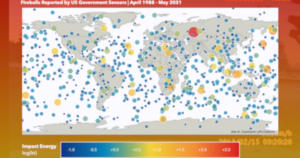This summer, the UWM Planetarium presents a new live virtual presentation, Dodging Doom, a sizzling scientific blockbuster aimed at inspiring interest and conversation about Earth’s defenses against potentially cataclysmic asteroid impacts.
Last year, as people around the globe were preoccupied with COVID-19, another menace nearly made its destructive presence known. On Aug. 16, 2020, an asteroid known as 2020 QG nearly made contact with our home planet, flying less than 2,000 feet above our heads at its closest approach – enough for Earth’s gravity to alter the space rock’s trajectory. At only 10-20 feet (3-6 meters) in diameter, it’s likely that 2020 QG would have resulted in a fireball as it broke up in our atmosphere, but the scary part is that it was detected after its close encounter.
In truth, instances such as these are common. Asteroids the size of 2020 QG pass by Earth a few times every year (though not as close) and, about once a year, the journey of an asteroid this size will end in a brilliant flash of light and fire as it passes through the atmosphere. Indeed, on any given night you can gaze up at the sky and, with a little patience, see streaks of light that signal the ignition of tiny particles of space rock and debris in our atmosphere.
It’s the larger asteroids, over 25 meters in diameter, that warrant our attention. And it’s not a question of whether Earth will be hit with a devastating asteroid – it’s when.
Presently, we don’t have a contingency plan for if a major threat were to hurdle our way. Scientists have put forth several as-yet untested proposals. It wasn’t until 2005 that the U.S. Congress tasked NASA with finding 90 percent of near-Earth asteroids that are 140 meters or larger, and NASA’s Planetary Defense Coordination Office was only established in 2016.
The good news is that NASA will soon launch the DART (DoubleAsteroid Redirection Test) spacecraft which travel to the binary near-Earth asteroid, Didymos, to test the kinetic impactor technique – a method in which an object crashes into a threatening asteroid to nudge its trajectory in a direction that won’t collide with Earth.
It is the launch of this mission that has inspired the UWM Planetarium program “Dodging Doom”. To find out more about Earth’s tumultuous history with space rocks, what we plan to do about them in the future, and how you can become a defender of Earth, visit uwm.edu/planetarium to register for one of the two live virtual presentations on July 14 and 16.
By Nathaniel Schardin, UWM Planetarium
